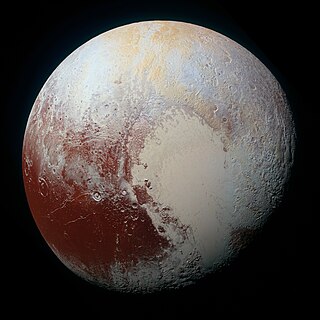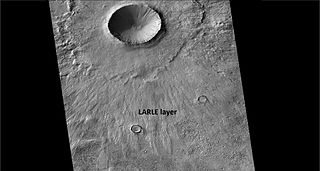External links
Wikimedia Commons has media related to Maps of Dione .
This is a list of named geological features on Dione , a moon of Saturn. Dionean geological features are named after people and places in Roman mythology.
Catenae are crater chains. They are named after rivers in Roman mythology.
| Catena | Pronunciation | Coordinates | Diameter (km) | Approval date | Named after | Refs |
|---|---|---|---|---|---|---|
| Aufidus Catena | /ˈɔːfɪdəs/ | 78°00′S296°24′W / 78.0°S 296.4°W | 275 | 2008 | Aufidus, river in southern Italy | WGPSN |
| Pactolus Catena | /pækˈtoʊləs/ | 8°47′N327°09′W / 8.79°N 327.15°W | 180 | 2008 | Pactolus, river in Lydia | WGPSN |
| Pantagias Catenae | /pænˈteɪdʒiəs/ | 15°18′S141°42′W / 15.3°S 141.7°W | 200 | 2008 | Pantagias, river in Sicily | WGPSN |
Dionean chasms or canyons are called chasmata /ˈkæzmətə/ . They are named after important locations in Roman mythology and history.
| Chasmata | Pronunciation | Coordinates | Diameter (km) | Approval date | Named after | Refs |
|---|---|---|---|---|---|---|
| Aurunca Chasmata | /ɔːˈrʌŋkə/ | 11°34′N266°42′W / 11.56°N 266.7°W | 290 | 2008 | Aurunca, Campania | WGPSN |
| Drepanum Chasma | /ˈdrɛpənəm/ | 46°N265°W / 46°N 265°W | 360 | 2008 | Drepanum, Sicily | WGPSN |
| Eurotas Chasmata | /jʊˈroʊtəs/ | 4°56′N301°21′W / 4.94°N 301.35°W | 1000 | 2008 | Eurotas River, Peloponnese | WGPSN |
| Larissa Chasma | /ləˈrɪsə/ | 28°59′N69°30′W / 28.98°N 69.5°W | 150 | 1982 | Larissa, Thessaly | WGPSN |
| Latium Chasma | /ˈleɪʃiəm/ | 20°00′N63°56′W / 20°N 63.93°W | 360 | 1982 | Latium, Italy | WGPSN |
| Padua Chasmata | /ˈpædjuə/ | 17°42′N247°10′W / 17.7°N 247.17°W | 1025 | 2008 | Padua, Veneto | WGPSN |
| Palatine Chasmata | /ˈpælətaɪn/ | 48°S316°W / 48°S 316°W | 1100 | 1982 | Palatine Hill, Rome | WGPSN |
| Tibur Chasma | /ˈtaɪbər/ | 60°00′N69°18′W / 60°N 69.3°W | 156 | 1982 | Tibur, Lazio | WGPSN |
Dionean ridges are called dorsa. They are named after Roman hills.
| Dorsa | Pronunciation | Coordinates | Diameter (km) | Approval date | Named after | Refs |
|---|---|---|---|---|---|---|
| Janiculum Dorsa | /dʒəˈnɪkjʊləm/ | 24°36′N144°06′W / 24.6°N 144.1°W | 900 | 2008 | Janiculum, Rome | WGPSN |
Dionean fossae /ˈfɒsiː/ (long narrow depressions) are named after cities, streets and rivers in Roman mythology.
| Fossa | Pronunciation | Coordinates | Diameter (km) | Approval date | Named after | Refs |
|---|---|---|---|---|---|---|
| Argiletum Fossae | /ɑːrdʒɪˈliːtəm/ | 65°11′N32°06′W / 65.18°N 32.1°W | 224 | 2011 | Argiletum, a street near the forum of ancient Rome | WGPSN |
| Arpi Fossae | /ˈɑːrpaɪ/ | 47°28′N130°48′W / 47.47°N 130.8°W | 330 | 2008 | Arpi, Apulia | WGPSN |
| Carthage Fossae | /ˈkɑːrθədʒ/ | 11°56′N336°10′W / 11.93°N 336.17°W | 500 | 2008 | Carthage, Tunisia | WGPSN |
| Clusium Fossae | /ˈkluːsiəm/ | 39°16′N301°32′W / 39.27°N 301.54°W | 260 | 2008 | Clusium, Tuscany | WGPSN |
| Fidena Fossae | /fɪˈdiːnə/ | 0°40′N96°00′W / 0.66°N 96°W | 550 | 2008 | Fidenae, Latium | WGPSN |
| Helorus Fossa | /hɪˈlɔːrəs/ | 31°50′S76°29′W / 31.84°S 76.48°W | 105 | 2011 | river Helorus, Sicily | WGPSN |
| Himella Fossa | /hɪˈmɛlə/ | 45°36′S336°33′W / 45.6°S 336.55°W | 147 | 2011 | river Himella, a tributary of the Tiber | WGPSN |
| Petelia Fossae | /pɪˈtiːliə/ | 8°10′S82°26′W / 8.16°S 82.43°W | 225 | 2008 | Petelia, Calabria | WGPSN |
Originally, three geological features were labelled lineae (bright wispy markings). However, later evidence from the Cassini probe revealed them to be icy chasms, and they were all renamed as such (see above).
Dionean craters are named after figures from Greek and Roman mythology, especially Virgil's The Aeneid .

An impact crater is a depression in the surface of a solid astronomical body formed by the hypervelocity impact of a smaller object. In contrast to volcanic craters, which result from explosion or internal collapse, impact craters typically have raised rims and floors that are lower in elevation than the surrounding terrain. Impact craters are typically circular, though they can be elliptical in shape or even irregular due to events such as landslides. Impact craters range in size from microscopic craters seen on lunar rocks returned by the Apollo Program to simple bowl-shaped depressions and vast, complex, multi-ringed impact basins. Meteor Crater is a well-known example of a small impact crater on Earth.

Planetary nomenclature, like terrestrial nomenclature, is a system of uniquely identifying features on the surface of a planet or natural satellite so that the features can be easily located, described, and discussed. Since the invention of the telescope, astronomers have given names to the surface features they have discerned, especially on the Moon and Mars. To found an authority on planetary nomenclature, the International Astronomical Union (IAU) was organized in 1919 to designate and standardize names for features on Solar System bodies.

Rhea is the second-largest moon of Saturn and the ninth-largest moon in the Solar System, with a surface area that is comparable to the area of Australia. It is the smallest body in the Solar System for which precise measurements have confirmed a shape consistent with hydrostatic equilibrium. It was discovered in 1672 by Giovanni Domenico Cassini.

Dione, also designated Saturn IV, is the fourth-largest moon of Saturn. With a mean diameter of 1,123 km and a density of about 1.48 g/cm3, Dione is composed of an icy mantle and crust overlying a silicate rocky core, with rock and water ice roughly equal in mass. Its trailing hemisphere is marked by large cliffs and scarps called chasmata; the trailing hemisphere is also significantly darker compared to the leading hemisphere.

Solfatara is a shallow volcanic crater at Pozzuoli, near Naples, part of the Phlegraean Fields volcanic area. It is a dormant volcano, which still emits jets of steam with sulfurous fumes. The name comes from the Latin, Sulpha terra, "land of sulfur", or "sulfur earth". It was formed around 4000 years ago and last erupted in 1198 with what was probably a phreatic eruption – an explosive steam-driven eruption caused when groundwater interacts with magma. The crater floor was a popular tourist attraction until 2017, as it has many fumaroles and mud pools. The area is well known for its bradyseism. The vapours had been used for medical purposes since Roman times.

The moons of Saturn are numerous and diverse, ranging from tiny moonlets only tens of meters across to the enormous Titan, which is larger than the planet Mercury. There are 146 moons with confirmed orbits, the most of any planet in the solar system. This number does not include the many thousands of moonlets embedded within Saturn's dense rings, nor hundreds of possible kilometer-sized distant moons that were seen through telescopes but not recaptured. Seven Saturnian moons are large enough to have collapsed into a relaxed, ellipsoidal shape, though only one or two of those, Titan and possibly Rhea, are currently in hydrostatic equilibrium. Three moons are particularly notable. Titan is the second-largest moon in the Solar System, with a nitrogen-rich Earth-like atmosphere and a landscape featuring river networks and hydrocarbon lakes. Enceladus emits jets of ice from its south-polar region and is covered in a deep layer of snow. Iapetus has contrasting black and white hemispheres as well as an extensive ridge of equatorial mountains among the tallest in the solar system.

In ancient Greek religion and Greek mythology, Dione is an oracular goddess, a Titaness primarily known from Book V of Homer's Iliad, where she tends to the wounds suffered by her daughter Aphrodite. Dione is presented as either an Oceanid, daughter of Oceanus and Tethys, or the thirteenth Titan, daughter of Gaia and Uranus.
This is a directory of lists of geological features on planets excepting Earth, moons and asteroids ordered by increasing distance from the Sun.
Dione is the name of four women in ancient Greek mythology, and one in the Phoenician religion described by Sanchuniathon. Dione is translated as "Goddess", and given the same etymological derivation as the names Zeus, Diana, et al. Very little information exists about these nymphs or goddesses, although at least one is described as beautiful and is sometimes associated with water or the sea. Perhaps this same one was worshiped as a mother goddess who presided over the oracle at Dodona, Greece and was called the mother of Aphrodite.

A low-aspect-ratio layered ejecta crater is a class of impact crater found on the planet Mars. This class of impact craters was discovered by Northern Arizona University scientist Professor Nadine Barlow and Dr. Joseph Boyce from the University of Hawaii in October 2013. Barlow described this class of craters as having a "thin-layered outer deposit" surpassing "the typical range of ejecta". "The combination helps vaporize the materials and create a base flow surge. The low aspect ratio refers to how thin the deposits are relative to the area they cover", Barlow said. The scientists used data from continuing reconnaissance of Mars using the old Mars Odyssey orbiter and the Mars Reconnaissance Orbiter. They discovered 139 LARLE craters ranging in diameter from 1.0 to 12.2 km, with 97% of the LARLE craters found poleward of 35N and 40S. The remaining 3% mainly traced in the equatorial Medusae Fossae Formation.